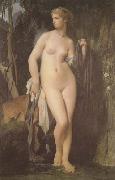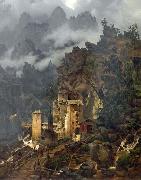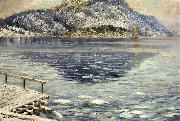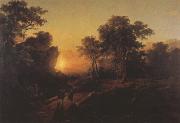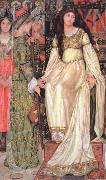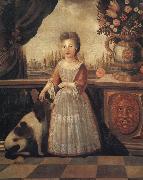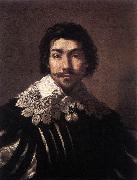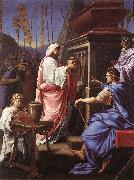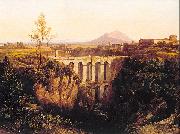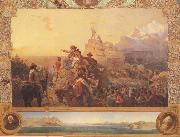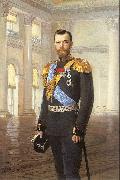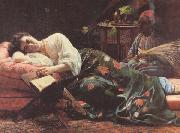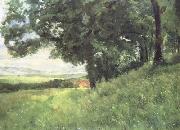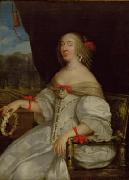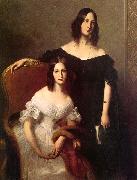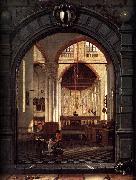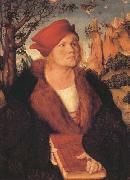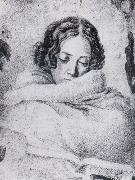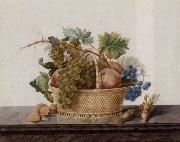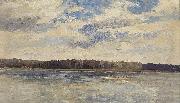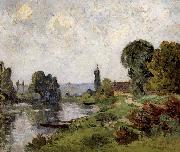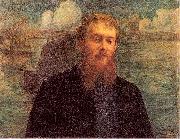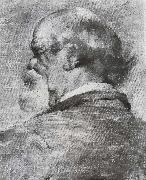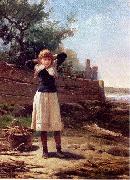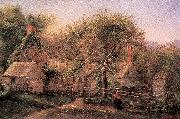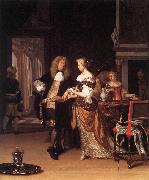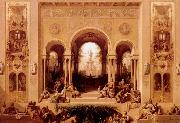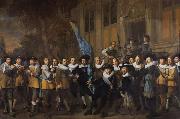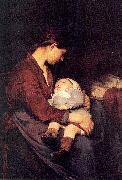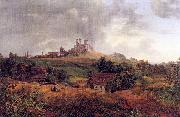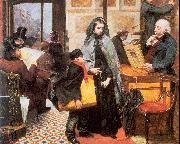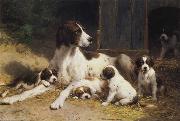|
|
|
|
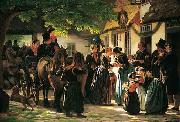 |
Julius Exner
|
|
(November 30, 1825-November 15, 1910), Danish genre painter, was born in Copenhagen to Johann Gottlieb Exner, a Czech musician from Bohemia, who came to Denmark during the Napoleonic period, and his wife Karen Jørgensdatter. Exner originally intended on becoming a history painter, but quickly found his niche, however, in genre painting, the most popular and lucrative painting style of his era. |
|
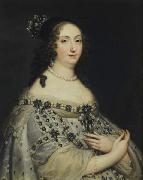 |
Justus van Egmont
|
|
Justus van Egmont (Leiden, 22 September 1601 - Antwerp, 8 January 1674) was a Dutch Golden Age painter and designer of tapestry.
Justus van Egmont moved to Antwerp at age 14 with his family where he became apprenticed to the painter Caspar van den Hoecke (ca. 1585 - ca 1648). In 1618, three years later, he undertook a Grand Tour to Italy in the manner of other artists of his day. This was considered a necessary rite of passage for artists after Karel van Mander published his Schilderboeck in 1604. |
|
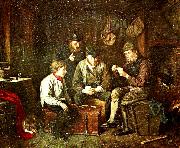 |
k. e. jansson
|
|
Karl Emanuel Jansson, född 7 juli 1846 i Finström, Åland, död 1 juni 1874 i Jomala, var en åländsk konstnär. Han var näst äldst av sju syskon. Han far, Jan Jansson, var en bonde i Pålsböle.
Sina konstnärliga inspiration fick han av sockenmålaren G Kjellgren, vid sex-sju års ålder, när han där lärde sig att läsa och skriva. Efter avlutad skolgång sattes han i skomakarlära. Efter ett år drogs han till Kjellgren och fungerade som hans hjälpreda. Kyrkoherden Frans von Knorring såg i slutet av 1859 några av hans teckningar. Han sände några till Finska Konstföreningens direktion och lovordade Karl.
Förening gav ett bidrag för att kunna studera vid Finska Konstföreningens ritskola i Åbo, under ledning av Robert Wilhelm Ekman. Av Ekman fick han husrum, rit- och målningsmaterial och en hel del extra undervisning. Karl gjorde stora framsteg under de 2 åren han målade med Ekman.
Jansson flyttade hösten 1862 till Stockholm, för att kunna utvecklas mer som artist, och inskrevs som elev vid Kongl. Akademin för de fria konsterna. Han tog anatomiexamen 1863. Han levde under svåra ekonomiska förhållanden och hade svårt att sälja sina verk.
Jansson fick hård kritik för de målningar han sände hem, exempelvis, Babian ätande en råtta, och konstföreningen betraktade dem med avsky. Han började då kritisera sig själv allt mer och mer, och den inställningen behöll han. Han fick inte den uppmärksammad han behövde. Tavlan Den förlorade sonens återkomst, belönades med ett pris. Han avslutade sin utbildning vid akademien 1867 med mycket beröm. Jansson lyckades utverka statsstöd för studier i Dusseldorf och reste dit på hösten 1868. Han åkte hem igen sommaren 1870 och tillbringade ett år på Åland innan han återvände till Dusseldorf.
Han var nu märkt av en tilltagande lungsjukdom. De sista verk han fullbordade var Talmannen och En slant i håven. För att lindra sin sjukdom reste han till Rom i mars 1872. Efter några månader åkte han runt till olika kurorter (Davos, Meran) men inget förbättrade hans tillstånd. Efter en liten tid i D??sseldorf kom han hem till Åland sensommaren 1873.
Karl flyttade in på Jomala gård, där lagman Lönnblad och hans fru tog hand om honom. Han målade några verk, vilka blev ofullbordade. På dödsbädden fick han veta att han belönats på världsutställningen i Wien för sina konstverk Klöveress och Talmannen, samt att han blivit medlem i konstakademin i Sankt Petersburg. Han dog 1 juni 1874, inte ens fylld 28 år. |
|
|
|
|
|
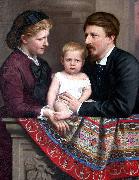 |
Karl Ernst Papf
|
|
Karl Ernest Papf (Dresden, Germany, 1833 -Sao Paulo, 1910) was a German painter, and draftsman that moved to Brazil in 1867.
He studied in the Academy of Fine Arts of Dresden and in 1867, was hired for the profession of photographer by the firm of his compatriot Albert Henschel. He initially worked in Recife until 1872, then in Salvador until 1877 - always in service of the atelier Albert Henschel & Cia., as written in Almanak Laemmert. He moved to Rio de Janeiro in surch for a better environment for the development of his work. |
|
|
|
|
|
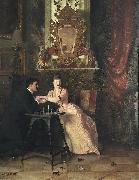 |
Knut Ekwall
|
|
was a Swedish painter, 3 April 1843 in Säby (Småland province), Sweden - 4 April 1912 in Säby.
Ekwall studied from 1860-1866 at the Academy of Arts in Stockholm, with emphasis on xylography (designing woodcut printing blocks) and drawing.
He became a pupil of the painter Ludwig Knaus in Berlin.
In 1870, Ekwall established himself as an artist in Munich in Germany and later worked in Leipzig.
His works during this period were primarily for magazine illustrations, and were reproduced as engravings.
He returned to Sweden and died there at the age of 69.
|
|
|
|
|
|
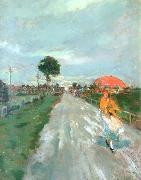 |
Lajos Deak-ebner
|
|
(1850- 1934 ) - Painter
painted On the Road in between 1876(1876) and 1880(1880)
|
|
 |
Landseer, Edwin Henry
|
|
RA (7 March 1802 - 1 October 1873) was an English painter, well known for his paintings of animalseparticularly horses, dogs and stags. The best known of Landseer's works, however, are sculptures: the lions in Trafalgar Square, London.
|
|
|
|
|
|
|
|
|
|
|
|
|
|
|
|
|
|
 |
Louis Michel Eilshemius
|
|
(February 4, 1864 - December 29, 1941) was an American painter, primarily of landscapes and nudes. Although he was academically trained, much of his work has the unself-aware character of naive art. Eilshemius was a grandson of Swiss painter Louis-Leopold Robert.
Born near Newark, New Jersey into a wealthy family, his earliest education was in Europe, after which he spent two years at Cornell University before his art studies began at the Art Students League of New York. He subsequently studied under Bouguereau at the Academie Julian in Paris, and traveled widely in Europe, Africa and the South Seas, returning to the family brownstone in New York City where he was to live for the rest of his life. |
|
|
|
|
|
|
|
|
|
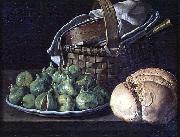 |
Luis Egidio Melendez
|
|
(Naples, 1716-Madrid, 1780) was a Spanish painter. Although he received little acclaim during his lifetime and died in poverty, Melendez is recognized today as the greatest Spanish still-life painter of the 18th century. His mastery of composition and light, and his remarkable ability to convey the volume and texture of individual objects enabled him to transform the most mundane of kitchen fare into powerful images.
Luis Egidio Melendez de Rivera Durazo y Santo Padre was born in Naples in 1716. His father, Francisco Melendez de Rivera Diaz (1682- after 1758), was a miniaturist painter from Oviedo who had moved to Madrid with his older brother, the portrait painter Miguel Jacinto Melendez (1679-1734) in pursuit of artistic instruction. Whereas Miguel remained in Madrid to study and became a painter in the court of Philip V, Francisco left for Italy in 1699 to seek greater artistic exposure. Francisco took a special interest in visiting the Italian academies and settled in Naples where he married Maria Josefa Durazo y Santo Padre Barrille.Luis was a year old when his father, who had been a soldier in a Spanish garrison and lived abroad for almost two decades, returned to Madrid with the family. Luis Egidio, his brother Jose Agusten, and Ana, one of his sisters, began their careers under the tutelage of their father, who was appointed the King's Painter of Miniatures in 1725.After several years, in his words: painting royal portraits in jewels and bracelets to serve as gifts for envoys and ambassadors, he entered the workshop of Louis Michel van Loo (1707-1771), a Frenchman who had been made royal painter of Philip V of Spain. Between 1737 to 1742, Melendez worked as a part of a team of artist dedicated to copying van Loo's prototypes of royal portraits for the domestic and overseas market, but at least he had a foothold in the palace. He had his artistic sights on a distinguished career as a court painter. |
|
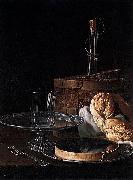 |
Luis Eugenio Melendez
|
|
(Naples, 1716-Madrid, 1780) was a Spanish painter. Although he received little acclaim during his lifetime and died in poverty, Melendez is recognized today as the greatest Spanish still-life painter of the 18th century. His mastery of composition and light, and his remarkable ability to convey the volume and texture of individual objects enabled him to transform the most mundane of kitchen fare into powerful images.
Luis Egidio Melendez de Rivera Durazo y Santo Padre was born in Naples in 1716. His father, Francisco Melendez de Rivera Diaz (1682- after 1758), was a miniaturist painter from Oviedo who had moved to Madrid with his older brother, the portrait painter Miguel Jacinto Melendez (1679-1734) in pursuit of artistic instruction. Whereas Miguel remained in Madrid to study and became a painter in the court of Philip V, Francisco left for Italy in 1699 to seek greater artistic exposure. Francisco took a special interest in visiting the Italian academies and settled in Naples where he married Maria Josefa Durazo y Santo Padre Barrille. Luis was a year old when his father, who had been a soldier in a Spanish garrison and lived abroad for almost two decades, returned to Madrid with the family. Luis Egidio, his brother Jose Agusten, and Ana, one of his sisters, began their careers under the tutelage of their father, who was appointed the King's Painter of Miniatures in 1725. After several years, in his words: painting royal portraits in jewels and bracelets to serve as gifts for envoys and ambassadors, he entered the workshop of Louis Michel van Loo (1707-1771), a Frenchman who had been made royal painter of Philip V of Spain. |
|
|
|
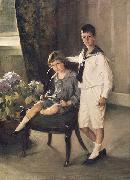 |
Lydia Field Emmet
|
|
(January 23, 1866 - August 16, 1952) was an American artist best known for her work as a portraitist. She studied with, among others, prominent artists such as William Merritt Chase, Henry Siddons Mowbray, Kenyon Cox and Tony Robert-Fleury. Emmet exhibited widely during her career, and her paintings can now be found hanging in the White House, and many prestigious art galleries, including the Metropolitan Museum of Art.
Emmet was born on January 23, 1866, at New Rochelle, New York, the seventh of ten children born to merchant William Jenkins Emmet and illustrator Julia Colt Pierson. |
|
|
|
|
|
|
|
 |
Marie Ellenrieder
|
|
Anna Marie Ellenrieder (March 20, 1791 - June 5, 1863, Konstanz) was a German painter.
She was born in Konstanz, Germany, the daughter of Konrad and Anna Maria Herrmann, and the granddaughter of Franz Ludwig Herrmann.
She studied under the miniature painter Joseph Einsle. Her portraits, similar in style to the ones of Angelica Kauffmann, made her the first woman to enter the Academy of Fine Arts Munich.
She spent the time between 1822 and 1824 in Rome, where she became a disciple of Friedrich Johann Overbeck. After this journey, she started painting religious topics such as "Christ Blessing Little Children" and "Mary and the Infant Jesus." Her two paintings "Der 12 jährige Jesus im Tempel / The 12 year old Jesus in the Temple", 1849 (oil on canvas, 203,2 x 139,7 cm) and "Hl Felicitas und ihre sieben Söhne / Holy Felicitas and her Seven Sons", 1847 (oil on canvas, 127 x 177,8 cm) were acquired by Queen Victoria who had been introduced to her work by the Prince Consort, who in turn had encountered the artist on his travels to Rome. They are now part of the Royal Collection in Osborne House.
She died in her home town of Konstanz. |
|
|
|
|
|
|
|
|
|
|
|
|
|
|
|
|
|
|
|
|
|
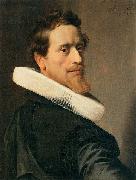 |
Nicolaes Eliaszoon Pickenoy
|
|
(10 January 1588 - 1653/1656) was a Dutch painter of Flemish origin. Pickenoy was possibly a pupil of Cornelis van der Voort and presumably Bartholomeus van der Helst was his own pupil.
He was the son of the Antwerp monumental mason Elias Claeszoon Pickenoy (1565-1640) and Heijltje Laurens s'Jonge (1562-1638), who emigrated to Amsterdam before Nicolaes Pickenoy was born. In 1621, living near the Oude Kerk, he married Levijntje Bouwens (1599-na 1656), an orphan of 21 years. They had ten children: Sara and Elias died young.
Pickenoy painted large Schuttersstukken, group portraits of the regents of the orphanage, and individual portraits of local or national celebrities like Nicolaes Tulp, Cornelis de Graeff, Maarten Harpertszoon Tromp and Jochem Hendrickszoon Swartenhont, Elisabeth Bas's husband. The earliest picture ascribed to the artist is "Dr. Sebastiaen Egbertz de Vrij's Osteological Presentation" of 1619, now in Amsterdam Historisch Museum. His heyday was ca. 1630-1637, a period marked by a high artistic level and numerous commissions from prominent patrons. After 1637 he painted little, save for a number of prestigiouseand lucrativeegroup portraits. Besides portraits, he also painted a small number of biblical subjects, one of which can be seen in the Museum Catharijneconvent. The Rijksmuseum Amsterdam and Amsterdams Historisch Museum holds many of his best works, not least the Schutterstukken or militia paintings.
In 1637 he bought from Adriaen Pauw the house on the corner of Sint Anthoniessluis and Jodenbreestraat, a fashionable area with many painters, art dealers, jewellers and so on. The house had previously been owned by his supposed master, Cornelis van der Voort, and later by Hendrick van Uylenburgh. During the years 1631-1634 the latter was collaborating with Rembrandt van Rijn, who painted numerous portraits for Van Uylenburgh's art business. Thus the house Pickenoy purchased had been a centre of Amsterdam portraiture for decades. In 1639 Rembrandt returned to the neighbourhood as he bought the house next to Pickenoys, the present day Rembrandthuis. Rembrandt could leave his house via an exit onto the Zwanenburgwal under the house of his neighbor Pickenoy. He brought out Night Watchepainted in his courtyarderolled up through the tunnel. Like Rembrandt, Pickenoy was not able to bring up the loan and so after eight years he sold the house.
The work of Pickenoy is difficult to distinguish from that of some of his contemporaries. Typical of Pickenoy are the fiercely invading light that makes the heads stand out sharply, the somewhat exaggerated gestures, the large greenish brown shadows and the odd-shaped eyes.
|
|
|
|
|
|
|
|
|
|
|







